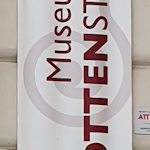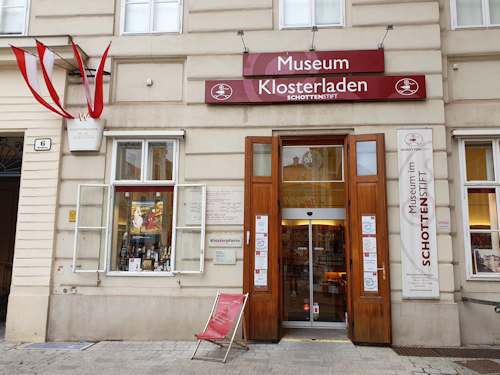
The Schottenstift abbey at the heart of Vienna can look back on centuries of tradition, history…and art. The small “in-house” museum showcases some of the treasures accumulated over the years.
- Mix of paintings, sculptures, historical documents, furniture, and ecclesiastical items
- Home to the Schottenaltar 15th-century altar panels
- Only a few rooms, so quick to get around
- Book tickets for Stephansdom cathedral* in Vienna
- See also:
The “Museum im Schottenstift”

(The museum entrance is also the shop entrance)
Vienna likes its historical buildings, especially those grand 19th-century imperial constructions and town palaces designed to one-up the aristocratic neighbours.
All the above are fly-by-night newcomers compared to the Schottenstift abbey. Mere pups, babies, kittens. Mayflies to the abbey’s elephant.
Irish monks established Schottenstift back in the 12th century at the invitation of the fabulously-named Duke Heinrich II. Jasomirgott.
Since religious institutions traditionally sponsored the arts, the abbey accumulated quite a collection of paintings and other valuable items over the years; the Schottenstift Museum presents many of the highlights.
Rooms that once housed the abbot offer a pot pourri of art, furniture, ecclesiastical treasures, historical relics and more, ranging from the surreal (stuffed squirrels) to the sublime (15th-century altar panels).
So what caught my attention?
The highlights
The clear centerpiece of the museum’s collections is the Schottenaltar, with its painted altar panels from around 1470: masterpieces of medieval art produced by an anonymous painter who now bears the name of Schottenmeister.
Although the paintings depict the life of Mary and the Passion of Jesus, the background scenes in two of the panels feature Vienna at the time the Schottenmeister wielded their brush.
As such, those two panels are of vital historical significance:
- The Flight from Egypt offers a broad view of 15th-century Vienna that includes the city fortifications, Stephansdom, and other buildings. This is the earliest halfway reliable record of how Vienna looked in the past: a little smaller with far fewer rooftop jacuzzies.
- The Visitation features what is now Spiegelgasse, a street which branches off the cathedral square (Stephansplatz) in Vienna’s old town.
Quite apart from the impact of viewing something of such majesty created over 550 years ago, do take delight in the detail. In that Flight from Egypt panel, for example, a little bird sits on the wall next to Joseph.
Other joys that piqued my interest:
- An 18th-century (I think) painting of the interior of Stephansdom by Johann Leonhard Herrlein, showing no seating and less decorative elements than in today’s cathedral.
- The museum features numerous paintings, where the highlights are probably the 16th, 17th and 18th century Dutch and Flemish works. My personal favourite: the painting by Marten de Vos (1532 – 1603) of John the Baptist preaching.
- The room in its original 1830s condition, complete with Biedermeier furniture featuring an ebonised pear veneer.
- Two paintings by Jakob Alt of the abbey from before and after the alterations of around 1826.
- The prelate key that belonged to Abbot Carl Fetzer (1705–1750). Think of the kind of key that opens great iron locks on mysterious vaults that contain small chests best left untouched lest dark prophecies come true.
- Beautiful liturgical items encrusted with precious gemstones.
- Old books (my favourites), such as the illuminated New Testament from the 15th century or the 1563 animal encyclopedia with its drawing of what is allegedly meant to be a dromedary camel.

(Palais Harrach and the Schottenkirche around 1725; drawn by Salomon Kleiner, engraved by Johann August Corvinus and published by Johann Andreas d. Ä. Pfeffel; Wien Museum Inv.-Nr. 105765/48; excerpt reproduced with permission under the terms of the CC0 licence)
Tickets & visitor tips
At the time of writing, a standard adult ticket cost €8, though a Vienna Pass (my review) gets you in once for free.
- The museum does not open every day or all year round, so check the website before visiting.
- Exhibit labels were all in German on my visit, but look for the blue laminated English-language guides in each gallery. These introduce you to the room and its contents, particularly any paintings hanging on the walls.
- Buy your tickets from the Schottenstift shop counter (enter the museum itself through a door and up some stairs at the back of the shop).
- The shop is quite large for a small museum. We often pick up little gifts here, particularly the beer, wines and spirits from the lands and hands of various religious orders.
- Wander into the abbey complex itself for a musical surprise: a plaque within lets you know that Franz Liszt used to stay here (his uncle lived in one of the houses).
- The abbey complex also hosts Café Diglas, which is one of the coffee houses we like to visit when in the centre of town. It has an outdoor area in the shade of a small grove of trees during warmer seasons.
- The abbey church dominates one side of the Freyung square in Vienna’s centre, which features various townhouses once owned by the nobility and the Bank Austria Kunstforum Wien contemporary art venue.
- For more altar panel paintings, consider a visit to Belvedere’s medieval collection or the ecclesiastical art at the start of the Kunstkammer chamber of wonders in the Kunsthistorisches Museum.
- For other religious institutions filled with historical treasures:
- Try the Dom Museum opposite Stephansdom cathedral in the centre of Vienna
- Take a day trip to the huge Baroque Benedictine Stift Melk (about an hour by train from Vienna), which also has an attached museum
- Drop in to the Klosterneuburg Abbey (just beyond the city borders) and, especially, its treasury
- Vienna’s Karlskirche church also has a small treasury
How to get to the Schottenstift
The Schottenstift museum entrance (actually the shop entrance) is off to the left of the church as you face it on the Freyung square in the heart of town.
Subway: Reach the Freyung easily by foot from the Schottentor (U2 line) or Herrengasse (U3 line) stations
Bus/tram: The Teinfaltstraße stop on the 1A bus line is basically outside the front door of the museum. By tram, take the 1, D or 71 to Rathausplatz/Burgtheater or use any of the trams that stop at Schottentor (the 1, D, 71, 37, 38, 40, 41, 42, 43, 44)
Address: Freyung 6, 1010 | Website